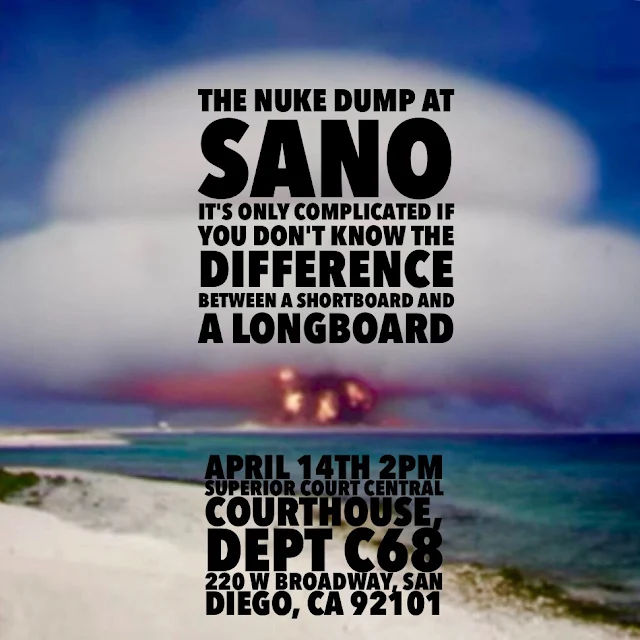Storing nuclear waste at San Onofre: it's only complicated if you can’t tell the difference between a shortboard and a longboard, and where each should be paddled out.
The Shortboard "Thin Can" VS Longboard "Thick Cask" Debate
Or let me put it to you this way so as to be perfectly clear.
YOU DON’T WANT NUCLEAR WASTE STORED IN THIN CANS ON THE BEACH AT SANO!
A “canister” OR “can” is like the ½ to ⅝ of an inch steel cans Edison has a permit for at San Onofre. A “cask” is a thick radwaste metal container up to 19 inches thick, this is an important distinction to make if we want to discuss safety at San Onofre from a factual point of view.
The Nuke Waste At Sano
The Issues From A Factual Point Of View
- This waste is onsite now, 3,600,000lbs of it.
- This waste has nowhere to go in the foreseeable future
- Edison has chosen thin walled cans over thick walled casks to store this radwaste, the NRC expects the waste to be here for 300 years.
- Each can would hold as much radiation as was released from the Chernobyl nuclear disaster, each can is only warrantied for 20 years.
- Edison promises these “Chernobyl Cans” won't leak. Do you forget the 40 year rating of the replacement steam generators? They lasted less than one year before leaking radiation, Edison lied about that radiation leak into our community for days after the event.
- Each can would have no internal monitoring.
- A can would have no "defense in depth" or “multiple layers of failure”
- Cans crack from exposure to salt air and engine exhaust
- There is no approved way to test or repair cracks in these cans.
- A cracked can, can have no seismic rating and cannot be transported
- Each can would be on the beach, straddling an earthquake fault, in a tsunami zone,
- Surrounded by millions of people, and thousands of surfers.
- Why are you still reading this? Toss these cans in the trash.
Rescind the Coastal permit for this badly planned nuke dump on the beach at San Onofre.
Demand Thick Walled Metal Casks, Not Cans
Make anything purchased for San Onofre Nuclear Waste match the location that we find ourselves in, using the best thick-wall cask technology available in the world. Let this become the standard of waste management.
Demand Thick Walled Metal Casks, Not Cans
Make anything purchased for San Onofre Nuclear Waste match the location that we find ourselves in, using the best thick-wall cask technology available in the world. Let this become the standard of waste management.
Safety should be our only concern.
UPDATE the April 14th 2PM hearing has been CANCELLED.
Superior Court Central Courthouse, Dept C68
220 W Broadway, San Diego, CA 92101
Google Maps Link https://goo.gl/maps/V9szQGEb9Sr
220 W Broadway, San Diego, CA 92101
Google Maps Link https://goo.gl/maps/V9szQGEb9Sr
Storing Nuclear Waste At San Onofre: It's only complicated if you are confused about the issues and don't want to think about the facts. #SaveTrestles our very own #StandingRock


